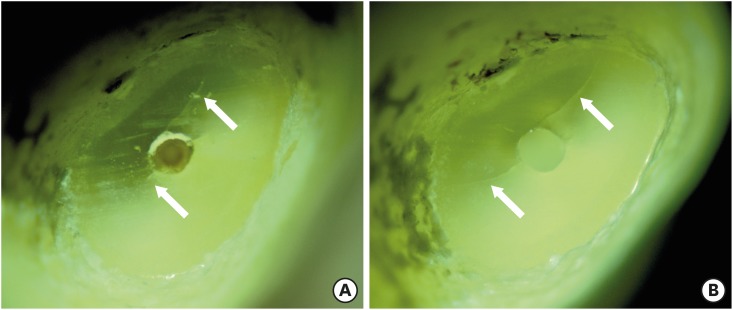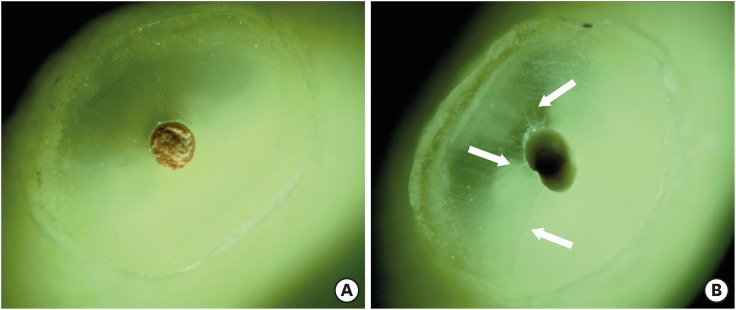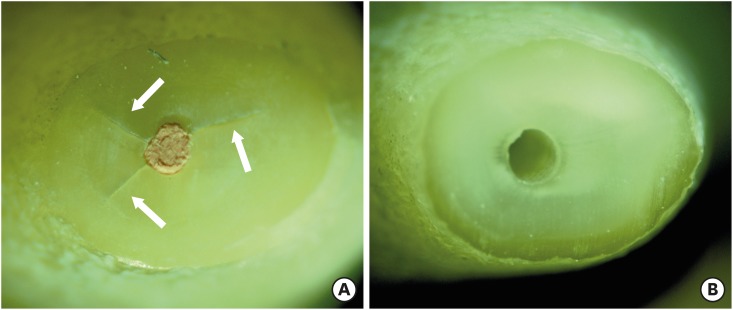Restor Dent Endod.
2017 Nov;42(4):332-341. 10.5395/rde.2017.42.4.332.
Incidence of apical crack formation and propagation during removal of root canal filling materials with different engine driven nickel-titanium instruments
- Affiliations
-
- 1Department of Endodontics, Ondokuz Mayıs University Faculty of Dentistry, Samsun, Turkey. gulsah.turkkan@hotmail.com
- 2Department of Endodontics, Bülent Ecevit University Faculty of Dentistry, Zonguldak, Turkey.
- 3Çorum Oral and Dental Center, Çorum, Turkey.
- KMID: 2403075
- DOI: http://doi.org/10.5395/rde.2017.42.4.332
Abstract
OBJECTIVES
To determine the incidence of crack formation and propagation in apical root dentin after retreatment procedures performed using ProTaper Universal Retreatment (PTR), Mtwo-R, ProTaper Next (PTN), and Twisted File Adaptive (TFA) systems.
MATERIALS AND METHODS
The study consisted of 120 extracted mandibular premolars. One millimeter from the apex of each tooth was ground perpendicular to the long axis of the tooth, and the apical surface was polished. Twenty teeth served as the negative control group. One hundred teeth were prepared, obturated, and then divided into 5 retreatment groups. The retreatment procedures were performed using the following files: PTR, Mtwo-R, PTN, TFA, and hand files. After filling material removal, apical enlargement was done using apical size 0.50 mm ProTaper Universal (PTU), Mtwo, PTN, TFA, and hand files. Digital images of the apical root surfaces were recorded before preparation, after preparation, after obturation, after filling removal, and after apical enlargement using a stereomicroscope. The images were then inspected for the presence of new apical cracks and crack propagation. Data were analyzed with χ2 tests using SPSS 21.0 software.
RESULTS
New cracks and crack propagation occurred in all the experimental groups during the retreatment process. Nickel-titanium rotary file systems caused significantly more apical crack formation and propagation than the hand files. The PTU system caused significantly more apical cracks than the other groups after the apical enlargement stage.
CONCLUSIONS
This study showed that retreatment procedures and apical enlargement after the use of retreatment files can cause crack formation and propagation in apical dentin.
MeSH Terms
Figure
Reference
-
1. Peters OA. Current challenges and concepts in the preparation of root canal systems: a review. J Endod. 2004; 30:559–567. PMID: 15273636.
Article2. Wilcox LR, Roskelley C, Sutton T. The relationship of root canal enlargement to finger-spreader induced vertical root fracture. J Endod. 1997; 23:533–534. PMID: 9587326.
Article3. Onnink PA, Davis RD, Wayman BE. An in vitro comparison of incomplete root fractures associated with three obturation techniques. J Endod. 1994; 20:32–37. PMID: 8182384.4. Shemesh H, Roeleveld AC, Wesselink PR, Wu MK. Damage to root dentin during retreatment procedures. J Endod. 2011; 37:63–66. PMID: 21146079.
Article5. Wu MK, van der Sluis LW, Wesselink PR. Comparison of mandibular premolars and canines with respect to their resistance to vertical root fracture. J Dent. 2004; 32:265–268. PMID: 15053908.
Article6. Kishen A. Mechanisms and risk factors for fracture predilection in endodontically treated teeth. Endod Topics. 2006; 13:57–83.
Article7. Sim TP, Knowles JC, Ng YL, Shelton J, Gulabivala K. Effect of sodium hypochlorite on mechanical properties of dentine and tooth surface strain. Int Endod J. 2001; 34:120–132. PMID: 11307260.
Article8. Bier CA, Shemesh H, Tanomaru-Filho M, Wesselink PR, Wu MK. The ability of different nickel-titanium rotary instruments to induce dentinal damage during canal preparation. J Endod. 2009; 35:236–238. PMID: 19166781.
Article9. Friedman S, Moshonov J, Trope M. Efficacy of removing glass ionomer cement, zinc oxide eugenol, and epoxy resin sealers from retreated root canals. Oral Surg Oral Med Oral Pathol. 1992; 73:609–612. PMID: 1518650.
Article10. Alapati SB, Brantley WA, Iijima M, Clark WA, Kovarik L, Buie C, Liu J, Ben Johnson W. Metallurgical characterization of a new nickel-titanium wire for rotary endodontic instruments. J Endod. 2009; 35:1589–1593. PMID: 19840654.
Article11. Ruddle CJ, Machtou P, West JD. The shaping movement: fifth-generation technology. Dent Today. 2013; 32:94.12. Gambarini G, Gergi R, Naaman A, Osta N, Al Sudani D. Cyclic fatigue analysis of twisted file rotary NiTi instruments used in reciprocating motion. Int Endod J. 2012; 45:802–806. PMID: 22429241.
Article13. Pedullà E, Lo Savio F, Boninelli S, Plotino G, Grande NM, Rapisarda E, La Rosa G. Influence of cyclic torsional preloading on cyclic fatigue resistance of nickel-titanium instruments. Int Endod J. 2015; 48:1043–1050. PMID: 25353957.14. Üstün Y, Topçuoğlu HS, Düzgün S, Kesim B. The effect of reciprocation versus rotational movement on the incidence of root defects during retreatment procedures. Int Endod J. 2015; 48:952–958. PMID: 25269890.15. Capar ID, Arslan H, Akcay M, Uysal B. Effects of ProTaper Universal, ProTaper Next, and HyFlex instruments on crack formation in dentin. J Endod. 2014; 40:1482–1484. PMID: 25146038.
Article16. Adorno CG, Yoshioka T, Jindan P, Kobayashi C, Suda H. The effect of endodontic procedures on apical crack initiation and propagation ex vivo . Int Endod J. 2013; 46:763–768. PMID: 23402216.17. Liu R, Kaiwar A, Shemesh H, Wesselink PR, Hou B, Wu MK. Incidence of apical root cracks and apical dentinal detachments after canal preparation with hand and rotary files at different instrumentation lengths. J Endod. 2013; 39:129–132. PMID: 23228272.
Article18. Zuolo AS, Mello JE Jr, Cunha RS, Zuolo ML, Bueno CE. Efficacy of reciprocating and rotary techniques for removing filling material during root canal retreatment. Int Endod J. 2013; 46:947–953. PMID: 23506150.
Article19. Topçuoğlu HS, Düzgün S, Kesim B, Tuncay O. Incidence of apical crack initiation and propagation during the removal of root canal filling material with ProTaper and Mtwo rotary nickel-titanium retreatment instruments and hand files. J Endod. 2014; 40:1009–1012. PMID: 24935554.
Article20. Kesim B, Üstün Y, Aslan T, Topçuoğlu HS, Şahin S, Ulusan Ö. Efficacy of manual and mechanical instrumentation techniques for removal of overextended root canal filling material. Niger J Clin Pract. 2017; 20:761–766. PMID: 28656933.
Article21. Gergi R, Sabbagh C. Effectiveness of two nickel-titanium rotary instruments and a hand file for removing gutta-percha in severely curved root canals during retreatment: an ex vivo study. Int Endod J. 2007; 40:532–537. PMID: 17511787.22. Tamse A. Vertical root fractures in endodontically treated teeth: diagnostic signs and clinical management. Endod Topics. 2006; 13:84–94.
Article23. Yoldas O, Yilmaz S, Atakan G, Kuden C, Kasan Z. Dentinal microcrack formation during root canal preparations by different NiTi rotary instruments and the self-adjusting file. J Endod. 2012; 38:232–235. PMID: 22244643.
Article24. Yared GM, Bou Dagher FE, Machtou P. Cyclic fatigue of ProFile rotary instruments after clinical use. Int Endod J. 2000; 33:204–207. PMID: 11307436.
Article25. Gambarini G. Cyclic fatigue of ProFile rotary instruments after prolonged clinical use. Int Endod J. 2001; 34:386–389. PMID: 11482722.
Article26. Alapati SB, Brantley WA, Svec TA, Powers JM, Mitchell JC. Scanning electron microscope observations of new and used nickel-titanium rotary files. J Endod. 2003; 29:667–669. PMID: 14606793.
Article27. Topçuoğlu HS, Demirbuga S, Tuncay Ö, Pala K, Arslan H, Karataş E. The effects of Mtwo, R-Endo, and D-RaCe retreatment instruments on the incidence of dentinal defects during the removal of root canal filling material. J Endod. 2014; 40:266–270. PMID: 24461416.
Article28. Kuttler S, McLean A, Dorn S, Fischzang A. The impact of post space preparation with Gates-Glidden drills on residual dentin thickness in distal roots of mandibular molars. J Am Dent Assoc. 2004; 135:903–909. PMID: 15354901.
Article29. Topçuoğlu HS, Düzgün S, Akpek F, Topçuoğlu G. Effect of glide path and apical preparation size on the incidence of apical crack during the canal preparation using Reciproc, WaveOne, and ProTaper Next systems in curved root canals: a stereomicroscope study. Scanning. 2016; 38:585–590. PMID: 26792649.
Article30. Nevares G, de Albuquerque DS, Freire LG, Romeiro K, Fogel HM, Dos Santos M, Cunha RS. Efficacy of ProTaper NEXT compared with Reciproc in removing obturation material from severely curved root canals: a micro–computed tomography study. J Endod. 2016; 42:803–808. PMID: 27117757.31. Özyürek T. Cyclic fatigue resistance of Reciproc, WaveOne, and WaveOne Gold nickel-titanium instruments. J Endod. 2016; 42:1536–1539. PMID: 27520406.
Article32. Zhou X, Jiang S, Wang X, Wang S, Zhu X, Zhang C. Comparison of dentinal and apical crack formation caused by four different nickel-titanium rotary and reciprocating systems in large and small canals. Dent Mater J. 2015; 34:903–909. PMID: 26632241.
Article33. Liu R, Hou BX, Wesselink PR, Wu MK, Shemesh H. The incidence of root microcracks caused by 3 different single-file systems versus the ProTaper system. J Endod. 2013; 39:1054–1056. PMID: 23880276.
- Full Text Links
- Actions
-
Cited
- CITED
-
- Close
- Share
- Similar articles
-
- Canal preparation with nickel-titanium or stainless steel instruments without the risk of instrument fracture: preliminary observations
- A comparison of master apical file size according to instrumentation in type II root canal
- Selection of Nickel-Titanium Files according to the Clinical Procedure and Factors of File Fracture: A Narrative Review
- Influence of root canal curvature on the screw-in effect of nickel-titanium rotary files in simulated resin root canal
- The effect of gutta-percha removal using nickel-titanium rotary instruments




